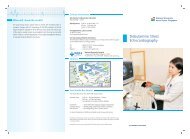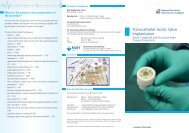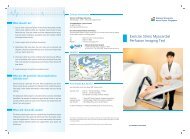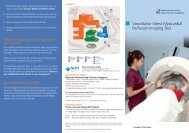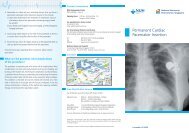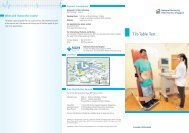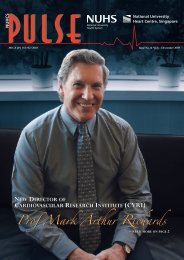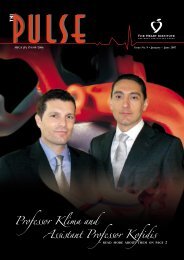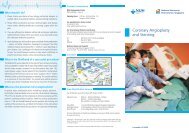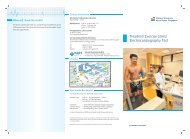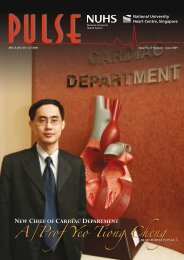Prof Chia Boon Lock receives the SMA Honorary ... - nuhcs
Prof Chia Boon Lock receives the SMA Honorary ... - nuhcs
Prof Chia Boon Lock receives the SMA Honorary ... - nuhcs
You also want an ePaper? Increase the reach of your titles
YUMPU automatically turns print PDFs into web optimized ePapers that Google loves.
SPOTLIGHT<br />
Information Technology<br />
@ The Heart Institute<br />
Dr James Yip & Ms Fauziah Azizi, Cardiac Dept @ NUH<br />
Within <strong>the</strong> ‘heart’ of operations at <strong>the</strong> The Heart Institute runs a<br />
unique software that has been storing critical information of our<br />
patients since 1991. This database, <strong>the</strong> cardiology information<br />
system (CIS) was initially spawned by <strong>Prof</strong>essor Maurice Choo,<br />
when he was <strong>the</strong>n chief of <strong>the</strong> cardiac department in NUH. It was<br />
initially a report generator for our echocardiography, treadmill<br />
and ambulatory blood pressure investigations and networked on a<br />
series of Macintosh computers. In 1998, <strong>the</strong> system was revamped<br />
to include research data and a new engine which helped<br />
cardiologists track <strong>the</strong>ir cases. In 2000, <strong>the</strong> system was moved to a<br />
Windows platform and <strong>the</strong> system was exported to Alexandra<br />
Hospital for use. It also boasted of a hospital interface which allowed<br />
its reports to be seen in NUH’s Hospital information system. We<br />
also developed an expert system for our percutaneous interventions<br />
which allowed full text reports to be generated from data captured<br />
during a procedure. We expanded our repertoire of investigations<br />
in <strong>the</strong> system to include 35 unique cardiology investigations ranging<br />
from Nuclear, CT angiography, Cardio-pulmonary exercise,<br />
Electrophysiology, congenital heart and vascular interventions.<br />
In 2001, we bravely entered <strong>the</strong> world of real time digital<br />
imaging. We began storing all images from echocardiography,<br />
cardiac ca<strong>the</strong>terization, electrocardiograms and nuclear. One of<br />
our overriding principles, was that all ‘raw’ source data from any<br />
system had to be stored and shared with everyone. In 2003, this<br />
database was installed in Tan Tock Seng Hospital and a National<br />
Heathcare Group (NHG) cardiology network was established. Our<br />
cardiology reports became available to <strong>the</strong> whole cluster in 2005<br />
on <strong>the</strong> computerized patient record system (CPRS). In 2003, we<br />
won a grant from The Enterprise Challenge from <strong>the</strong> Prime<br />
Minister’s office and we became <strong>the</strong> first medical unit in Singapore<br />
to use tablet personal computers for our daily ward rounds. This<br />
allowed all cardiology reports and images to be disseminated to<br />
<strong>the</strong> patients bedside. This improved our overall efficiency and<br />
allowed patients to have a shorter length of stay for our inpatients.<br />
In 2004, our CIS won <strong>the</strong> prestigious National Infocomm Awards<br />
from <strong>the</strong> Infocomm Development Authority (IDA) for <strong>the</strong> best<br />
implementation of IT in a public institution. In 2005, our IT<br />
director, Dr James Yip was inducted into <strong>the</strong> IT Hall of Fame of<br />
<strong>the</strong> Singapore Computing Society for <strong>the</strong> Friend of IT award.<br />
On a daily basis, <strong>the</strong> CIS allows our cardiologists to review<br />
patient information on a timely basis and to complete <strong>the</strong>ir<br />
cardiology reports. It has <strong>the</strong> capacity, for our doctors to work<br />
from home and to store interesting cases for teaching and research.<br />
The CIS contains coded fields which allows directed research to<br />
be conducted by our cardiologists and data to be collected<br />
prospectively. Thanks to this database, our research output each<br />
year grows by leaps and bounds, and doctors are able to submit<br />
numerous abstracts for local and overseas meetings, with some<br />
our young researchers frequently clinching young investigator<br />
awards. Part of <strong>the</strong> success of our CIS system, is that it is self<br />
developed and self managed. It is an organism which continually<br />
evolves to meet <strong>the</strong> new challenges, which is what expensive<br />
proprietary systems cannot promise to deliver. In <strong>the</strong> future<br />
development of <strong>the</strong> CIS, we hope to increase its connectivity<br />
to o<strong>the</strong>r systems and to deliver clinical decision support for<br />
<strong>the</strong> cardiologists.<br />
THI PULSE | 6



